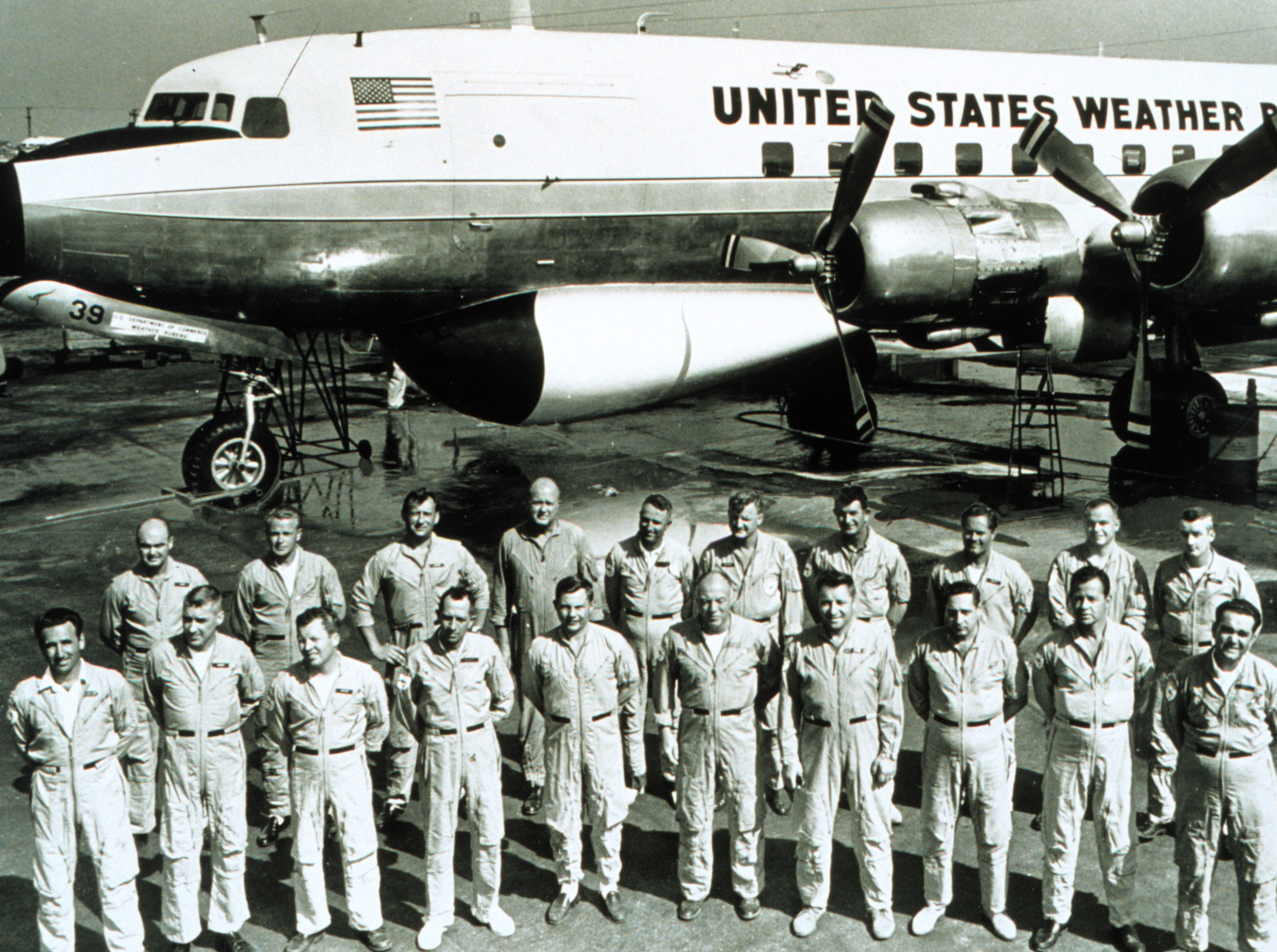Almost Science Fiction: Hurricane Modification and Project STORMFURY - National Weather Service Heritage

Almost Science Fiction: Hurricane Modification and Project STORMFURY
By Emily Senesac (emily.senesac@noaa.gov)The observation and understanding of hurricanes has always been a priority for the National Weather Service. Since its beginnings, the study of tropical cyclones has been at the forefront of this agency’s operations, with new technologies offering information on hurricanes over decades of research. In the years between 1962 and 1983, hurricane observation took an enormous step in a direction that almost sounds like science fiction: human interference and hurricane modification. Known as Project STORMFURY, the effort was undertaken by several government agencies, the Weather Bureau included.
Project STORMFURY sought to weaken tropical cyclones by flying aircraft into the storms and dispersing silver iodide through a process called cloud seeding. Cloud seeding is a type of weather modification that attempts to alter the processes of a cloud or storm by releasing a substance into the air. Using cloud seeding, the theory behind STORMFURY predicted that the iodide would cause a hurricane’s supercooled water -- water droplets that exist in liquid form at temperatures below freezing -- to freeze, thus disrupting the inner structure of the cyclone. To make up for this disruption, the hypothesis formulated, the wall of the storm’s eye would have to reform, thereby decreasing the maximum wind speeds by up to 30%. Since the amount of damage a hurricane can do relies heavily on the speed of its winds, even the smallest reduction could potentially make a huge difference in protecting lives and property. Therefore, the researchers on STORMFURY spent more than 20 years working to achieve this lofty goal.
The use of cloud seeding to alter a storm was not a new idea -- in fact, a weather modification program known as Project Cirrus accomplished the first cloud seeding of a hurricane back in 1947. However, instead of using silver iodide, this project experimented with dry ice as a method of seeding. Despite its ambitious nature, the successful seeding didn’t come without consequences: the hurricane, which had initially been tracking west to east and heading out to sea, reversed its path after it was seeded and made landfall in Savannah, Georgia, causing local destruction. Many blamed the seeding for this disaster, which had a negative effect on political and legal arrangements for future modification efforts. The project was officially canceled, and the embarrassing incident set back seeding research for more than a decade.
Efforts to explore modification didn’t resurface until the mid-1950s -- due to an incredibly active hurricane season with increased landfalls, Congress appropriated more money for hurricane research and mandated the establishment of the National Hurricane Research Project (NHRP). The NHRP had four main goals: to study hurricane formation, to study hurricane structure and dynamics, to seek means for forecasting improvement, and to seek means for hurricane modification. This final objective served as justification for Project STORMFURY, which began in earnest.
The criteria that a storm had to meet in order to be acceptable for the project were very specific; as a result, only a few hurricanes were actually seeded. To qualify, a hurricane had to have less than a 10% chance of making landfall within a day, be in the range of the seeding aircraft, and be an intense storm with a well-formed eye. Though the first official seeding was in 1961, the first seeding to be considered a success occurred in Hurricane Beulah in 1963: wind speeds fell by almost 20% as the iodide broke down the eye wall within the storm. However, while these results were promising, they were inconclusive -- more evidence was needed to prove the hypothesis. Unfortunately, no other seedings occurred until 1969, but that didn’t mean that Project STORMFURY was inactive. Instead, researchers focused on improving equipment. When Hurricane Debbie formed in 1969, meeting all of the necessary criteria, Project STORMFURY was ready. The observations and experiments for Debbie were successful, and the results of the seeding were consistent with the project hypothesis and the results of the Beulah seeding.
Despite this progress, it soon became clear that it was too difficult to find acceptable cyclones to work with. Additionally, it came to light that several hundreds of experiments would be needed in order to prove the feasibility of the hypothesis. Therefore, in the early 1970s, the focus of STORMFURY shifted from modifying hurricanes to better understanding them. As observation of hurricanes continued, new scientific data began to challenge the hypothesis of the project. Based on observational evidence, it was determined that the natural composition of hurricanes didn’t produce as much supercooled water as expected, and therefore seeding wasn’t as effective as intended. Furthermore, it became clear that the results of seeding were almost indistinguishable from changes in hurricane intensity that occurred naturally. By 1983, Project STORMFURY officially ended.
The mid- to late-1900s was a time of many big ideas in meteorology--it was only inevitable that some of them would be wrong. Though the goal of human manipulation of hurricanes was captivating and seemingly possible, the failure of Project STORMFURY proved that it was not yet attainable. Though the working hypothesis fell flat, many outcomes of the project left a lasting legacy on the NWS and on hurricane research. Instrument development, cloud dynamics research, numerical modeling all progressed as a result of STORMFURY. Additionally, this project fostered many of the institutions and approaches that form the basis of modern airborne hurricane research, including the acquisition of crucial airplane models. Most importantly, the observational data collected greatly expanded knowledge and understanding of hurricanes, even impacting forecasting practices today.
Additional Reading:
